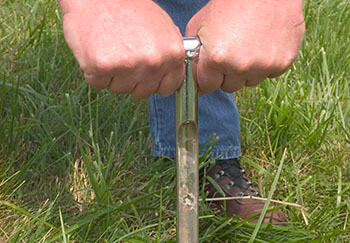Importance of Soil Sampling After Drought
Oct 05, 2020

Drought conditions can have a marked effect on your soil’s pH, nitrogen (N), phosphorus (P), and potassium (K) fertility levels. Soil testing is the best tool to identify a drought’s impact on your acreage and provide information needed to create a nutrient management plan.
Below you will find —
Normally, a drought will make your soil more acidic. Why? Because applied fertilizer will displace aluminum and hydrogen which lowers the soil pH, and moisture is required to release the potassium, calcium, and magnesium back into the soil to raise it. Fertilizers are often placed on the surface of the soil; therefore, a shallow soil sample could be misleading, showing a significantly lower soil pH.
Suggestion: Wait at least a couple of weeks after a good rain event, which should allow you to collect samples to the proper depth. However, if you have applied the full recommended rate of lime earlier in the season, do not apply additional lime regardless of the soil pH result. Once the soil has received moisture, the lime will proceed with its reaction.
Phosphorus and potassium
Several factors will affect the amount of residual P and K. Here are some questions to consider: What were the initial levels of P and K in the soil at the beginning of the season? Do you have sandy, coarse soil or fine soil? Did you harvest the field for grain or hay/silage?
Suggestion: Use a recent soil test. If you don’t have one, get one. If your P and K levels are high, optimum, or very high, you can calculate the amounts left in the field. If they are very low, low, or medium, apply the full recommended rate of P and K fertilizer. We recommend an annual soil test as part of your operation’s data collection.
Nitrogen
Drought conditions during the corn plant’s development can cause nitrogen to remain in the corn stalk, so nutrient-level calculations based on yield will likely be inaccurate.
Suggestion: Soil testing now for plant-available N will be helpful if you’re planting this fall or the field has cover crops. However, since much of the nutrient will be lost during the winter and early spring months, it’s best to test for nitrogen in the spring.
IMPORTANT TO NOTE: Soil sampling in dry soil conditions often increases sampling error. It is more difficult to control the sampling depth and accomplish proper soil core collection. If soils are dry and hard, getting a full 6-inch depth core can be difficult which means soil with lower soil-test levels will be missed.
For more information about soil testing, contact the trusted and knowledgeable agronomy team at your local Co-op.
The source for much of the information in this blog: “Drought Consideration in Soil Fertility,” Oscar F. Ruiz, Jr., DPM, and Pauric C. McGroary, PhD., Waypoint Analytical, Agronomy Facts 3, Revised July 23, 2015.
Below you will find —
- Explanation of drought’s effect on levels of pH, phosphorus, potassium, and nitrogen.
- Specific suggestions for using soil sampling to improve soil fertility levels.
Normally, a drought will make your soil more acidic. Why? Because applied fertilizer will displace aluminum and hydrogen which lowers the soil pH, and moisture is required to release the potassium, calcium, and magnesium back into the soil to raise it. Fertilizers are often placed on the surface of the soil; therefore, a shallow soil sample could be misleading, showing a significantly lower soil pH.
Suggestion: Wait at least a couple of weeks after a good rain event, which should allow you to collect samples to the proper depth. However, if you have applied the full recommended rate of lime earlier in the season, do not apply additional lime regardless of the soil pH result. Once the soil has received moisture, the lime will proceed with its reaction.
Phosphorus and potassium
Several factors will affect the amount of residual P and K. Here are some questions to consider: What were the initial levels of P and K in the soil at the beginning of the season? Do you have sandy, coarse soil or fine soil? Did you harvest the field for grain or hay/silage?
Suggestion: Use a recent soil test. If you don’t have one, get one. If your P and K levels are high, optimum, or very high, you can calculate the amounts left in the field. If they are very low, low, or medium, apply the full recommended rate of P and K fertilizer. We recommend an annual soil test as part of your operation’s data collection.
Nitrogen
Drought conditions during the corn plant’s development can cause nitrogen to remain in the corn stalk, so nutrient-level calculations based on yield will likely be inaccurate.
Suggestion: Soil testing now for plant-available N will be helpful if you’re planting this fall or the field has cover crops. However, since much of the nutrient will be lost during the winter and early spring months, it’s best to test for nitrogen in the spring.
IMPORTANT TO NOTE: Soil sampling in dry soil conditions often increases sampling error. It is more difficult to control the sampling depth and accomplish proper soil core collection. If soils are dry and hard, getting a full 6-inch depth core can be difficult which means soil with lower soil-test levels will be missed.
For more information about soil testing, contact the trusted and knowledgeable agronomy team at your local Co-op.
The source for much of the information in this blog: “Drought Consideration in Soil Fertility,” Oscar F. Ruiz, Jr., DPM, and Pauric C. McGroary, PhD., Waypoint Analytical, Agronomy Facts 3, Revised July 23, 2015.